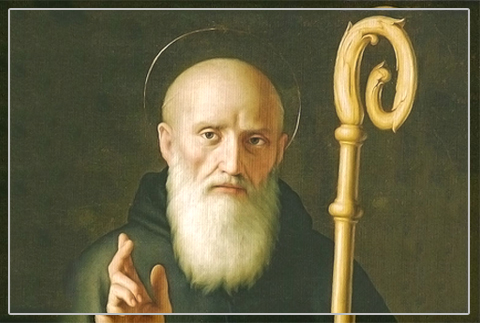It Began with Benedict

It Began with Benedict
On the occasion of the dedication of the rebuilt monastery of Monte Cassino in 1964, Pope Paul VI proclaimed St. Benedict the Principle heavenly Patron of Europe. The title in many respects is true. In fact the monasteries that later followed the Holy Rule of St. Benedict were places where learning and manuscripts were preserved. For some six centuries or more the Christian culture of medieval Europe was nearly identical with Benedictine Monastic centres of piety and learning.
Tradition teaches that St. Benedict lived from 480-547 AD. He was born to a distinguished family from Norcia, Central Italy. He was sent to Rome for his early education but when still young embarked upon the monastic life. For Benedict this flight was to a completely different way of life, to another set of values, to a whole new conception of what was involved in living the life at its best. Eventually accompanied by some monks on the summit of Monte Cassino, probably about 525 AD he founded his famous monastery, which today stands as the Mother House of the whole Benedictine Confederation. There he wrote the Rule by which his influence has been diffused far more than fifteen centuries. Thanks to the Rule’s remarkable flexibility monarchism was not frozen into one invariable type. The Rule adapted itself to places, to times, to civilizations, to the spiritual aspirations of generations of disciples among whom it nevertheless maintained the strong Benedictine bond of kinship.
To Benedictines St. Benedict is not so much founder as lawgiver, master and teacher of spiritual doctrine. It is in this capacity that he is Father and Founder to them. The monasteries of St. Benedict became places where Roman and Western culture was preserved and where the Gospel was spread. Under St. Gregory the Great, the first Benedictine Pope, the Benedictines became a great missionary force. St. Augustine and his companions were sent to convert England. Great monks like St. Wilford, St. Willibald, St. Willibrord, St. Ansgar and many other Benedictines established the monastic life in the still pagan countries. St. Boniface, another Benedictine, sowed his foundation in the barbaric regions of Germany before finding there the crown of martyrdom. To quote author Alfred Lapple: “The achievements of the Benedictine monks can be summarized by three symbols; the Cross (they were messengers of Christian faith), the Book (pioneers and preservers of Western culture), and the Plow (promoters of civilization and new settlements). According to English Historian Edward Gibbon, a single Benedictine monastery may have done more for the cause of knowledge than Oxford and Cambridge combined.
At a time when unsteady conditions and ever changing circumstances were most detrimental to the Church, when the Church was infected with heresies of Arius, Nestorius and Entyches and amidst the invasions of barbarous hordes, St. Benedict through the organization of his Order of monks in the west was instrumental in bringing about an enormous work of conversion and re-conquering the world for Christ: “It is wonderful”, says a historian, “how Divine Providence has manifested its care for the Church by calling St. Benedict for his great work because at the very time when all Italy, France, Spain and the Nothern Coast of Africa were in the possession of Goths and Vandals, and almost the entire East was infected with heresy, in this frightful darkness, so bright a light shone forth from St. Benedict and his Order, that the whole world was thereby illumined”.
The Benedictine family is one of the oldest orders in the Church, which between male and female members still are more than 20,000 scattered all over the world. Gregory I was the first of 50 Benedictines who have occupied the papal throne. The Order numbers about 60,000 saints recognized by the Church, all of whom are indebted to the Holy Rule of Benedict for their place upon it’s alters. It had included 20 emperors, 10 empresses, 47 kings, 50 queens and many other Royal and noble persons.
